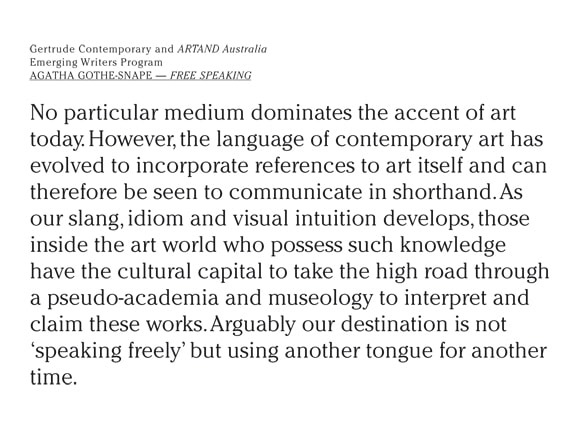programs

EMERGING WRITERS: AGATHA GOTHE SNAPE
Download catalogue here.
No particular medium dominates the accent of art today. However, the language of contemporary art has evolved to incorporate references to art itself and can therefore be seen to communicate in shorthand. As our slang, idiom and visual intuition develops, those inside the art world who possess such knowledge have the cultural capital to take the high road through a pseudo-academia and museology to interpret and claim these works. Arguably our destination is not ‘speaking freely’ but using another tongue for another time.
In the past I have likened Gothe-Snape’s work to that of a shape-shifter as she moves through a slipstream of mediums, passing through one to get to the next. The moniker also implies a sense of magic or trickery. Her practice is difficult to define, and yet her ability to evade a genre has become a signature feature of her approach, and of contemporary art more broadly — especially as it increasingly references social media and the diaspora created by digital access.
This exhibition comprises a series of nine framed drawings, hung in a single line that turns the corner of Gertrude Contemporary’s Studio 12 Project Space. Her sharpie drawings on butcher’s paper reference the simple aesthetic of street signage or an instructional diagram. The quick, black lines meet to satirise the three-dimensional shapes we use to communicate, such as an upside-down smart phone or a closed book. Their lo-fi pictographic quality is highlighted by her use of non-specialist, cheap and widely available tools. And, as a handwritten scribble can be unremarkable for what it is, but special for what it says, these images contain a deeper meaning.
With her images we can jump from suggestion, to cognition, to behaviour. Consider the following possibility: seeing a phone may prompt you to feel for one in your pocket, or go further and pull it out to take a photo to post online. From this point you enter into the Droste effect, a phenomena whereby an image is repeated within itself limitlessly, creating the impression of a mirrored infinity. This recursive and self-referential approach is present in the other works of Gothe-Snape’s, as well as her practice where one act, intervention or approach will seed into the next.
Gothe-Snape creates objects and experiences to transcend the binary pairing of question and answer. She is intent on keeping a cool, critical distance from the idea that the role of art has another purpose than its state of being, resisting a prescriptive function. Having to second-guess the artist’s intentions reminds us of the to and fro of a game of Pictionary. The game of making meaning in art is a back and forth, irreverent experience with room for mistakes and slippages. This is especially so, as with Pictionary, when the signifier is always inadequate to describe the sign.
Free Speaking underscores, in name and in subject, a pursuit for authorial anonymity. Perhaps this is because the artist has been re-reading the ‘Letter to Lord Chandos’ by Hugo von Hofmannsthal, an early twentieth-century fiction addressing the limits of language or its inability to get to the heart of things. The ‘Letter to Lord Chandos’ is, of course, and paradoxically, a crisis expressed in words.
In this way, Free Speaking delivers a critique of discourse using a discourse on the limits of expression. The power in her clever side-step of convention lies in the fact that the audience experience is indefinite, a result which can’t be qualified. Gothe-Snape’s atypical approaches to medium create meaning. By putting the most minimal amount of work into modifying a readymade she is testing the limits of what is permissible.